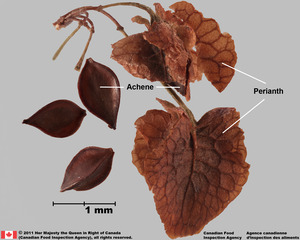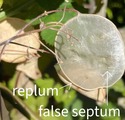Content is from Kirkbride et al. 2006Kirkbride et al. 2006:
Kirkbride JH, Jr, Gunn CR, and Dallwitz MJ. 2006. Family guide for fruits and seeds, vers. 1.0. Accessed September 2020-January 2022. URL: https://nt.ars-grin.gov/seedsfruits/keys/frsdfam/index.cfm ., without modification.
Updates are forthcoming.
Fruits: Pistil(s) simple; 1; 1-pistillate. Fruit pericarpium; simple; drupedrupe:
(indehiscent drupe) a fleshy, indehiscent fruit with one more hard pits enclosing seeds, derived from single, superior, simple or compound ovary; (dehiscent drupe) a fruit with a dry or fibrous to fleshy or leathery outer husk that early to tardily breaks apart (or opens), exposing one or more nutlike pits enclosing the seeds (like based on Gomez-Laurito & Gomez (1989)); without persistent central column; within accessory organ(s); within perianthperianth:
(like based on Gomez-Laurito & Gomez (1989)); without persistent central column; within accessory organ(s); within perianthperianth:
collective term for calyx and corolla of a flower
 ; 1-seeded; 1-seeded; without sterilesterile:
; 1-seeded; 1-seeded; without sterilesterile:
lacking male and/or female reproductive parts; also, not producing fruit or seed
 carpels; apexapex:
carpels; apexapex:
the point farthest from the point of attachment, or the "tip" of an organ not beaked; dehiscentdehiscent:
not beaked; dehiscentdehiscent:
(v. dehisce) splitting open at maturity to release contents (of a fruit) . Dehiscentdehiscent:
. Dehiscentdehiscent:
(v. dehisce) splitting open at maturity to release contents (of a fruit) without replumreplum:
without replumreplum:
the rim, formed by the persistent placentas, and connected by a false septum in Brassicaceae fruits. The fruit valves are attached to this rim and separate from it in dehiscent fruits. . Epicarpepicarp:
. Epicarpepicarp:
outer layer of fruit wall or pericarp, if divided into layers; note here used synonymously with exocarp durable; without armature; without wing(s); without apicalapical:
durable; without armature; without wing(s); without apicalapical:
at or pertaining to the end of the seed or fruit distal from its point of attachment (i.e., base)
respiratory hole. Endocarpendocarp:
the inner layer of the pericarp, if divided into layers present; bonybony:
present; bonybony:
very hard and rather brittle, like bone
; without operculumoperculum:
a dehiscent cap (or lid) of a seed or fruit that opens during germination or dehiscence ; without secretory cavities; without longitudinallongitudinal:
; without secretory cavities; without longitudinallongitudinal:
of or relating to length or the lengthwise dimension
ridges. Funiculusfuniculus:
(alt. funicle) stalk connecting the ovule (later seed) to the ovary (later fruit) placenta short; short without seed bearing hookswith hooks:
short; short without seed bearing hookswith hooks:
bristles or spines with curved or backwards pointing tips, or with secondary bristles along their length (retinacula); not persisting in fruit after seed shed.
(retinacula); not persisting in fruit after seed shed.
Seeds: Seed larger than minute; not bowl shaped; not nutlike; without winglike beakbeak:
a usually firm, terminal appendage, sometimes tapered ; without caudatecaudate:
; without caudatecaudate:
tapering to a long, tail-like appendage appendage(s); at maturity with food reserves; with endosperm; without canavanine. Sarcotestasarcotesta:
appendage(s); at maturity with food reserves; with endosperm; without canavanine. Sarcotestasarcotesta:
pulpy or fleshy outer layer of the seed coat, simulates aril absent. Testatesta:
absent. Testatesta:
seed coat
 present; without fleshy or leatheryleathery:
present; without fleshy or leatheryleathery:
texture—moderately thick, tough, and very pliable
layer over hard layer; without glands; without bristles; without wings; without collar; without operculumoperculum:
a dehiscent cap (or lid) of a seed or fruit that opens during germination or dehiscence ; colored; monochrome; not becoming mucilaginousmucilaginous:
; colored; monochrome; not becoming mucilaginousmucilaginous:
resembling mucilage; moist and sticky
when wetted. Endosperm scant; without fatty acid containing cyclopropene; without apicalapical:
at or pertaining to the end of the seed or fruit distal from its point of attachment (i.e., base)
lobes; without chlorophyll; without isodiametric faceted surface; without odor. Embryo differentiated from food reserve; well developed; partially filling testatesta:
seed coat
 (with food reserve); at one end of seed not extending into a depression or cup; axileaxile:
(with food reserve); at one end of seed not extending into a depression or cup; axileaxile:
on or of the axis
and centric; straight; without coleorhiza; without simmondsin; with cotyledons containing oils; without stomata; not green; with 2 or more cotyledons (assumed). Cotyledons 2 (assumed); equal in size; not punctatepunctate:
surface relief - dotted with pits or with translucent, sunken glands or with colored dots, similar to pitted dotted.
dotted.
Gomez-Laurito & Gomez P. (1991): "Fruit drupaceous, 1-seeded. Embryo oily with straight cotyledons. Ovary inferior, bicarpellate, including perianth tube". Gomez-Laurito & Gomez P. (1989): " Fruit asymmetrical, unilateral somewhat swollen on 1 side, ovate, base rounded, apex acute, drupaceous, ca. 7 cm. long, green. mucilaginous; endocarp very hard, longitudinally furrowed; endosperm scanty; 1 seed per fruit. "The dry, hardened fruits bear a faint resemblance to those of Coryllus L., and, when we frist saw a vegetative specimen, we thought of Carpinus L. which reaches northern Nicaragua".
Literature specific to this family: Gómez-Laurito, J. & L.D. Gomez P. 1989. Ticodendron: A new tree from Central America. Ann. Missouri Bot. Gard. 76:1148–1151; Tobe, H. 1991. Reproductive morphology, anatomy, and relationships of Ticodendron. Ann. Missouri Bot. Gard. 78:135–142; Gómez-Laurito, J. & L.D. Gomez P. 1991. Ticodendraceae: A new family of flowering plants. Ann. Missouri Bot. Gard. 78:87–88.
General references: Gunn, C.R., J.H. Wiersema, C.A. Ritchie, & J.H. Kirkbride, Jr. 1992 & amendments. Families and genera of Spermatophytes recognized by the Agricultural Research Service. Techn. Bull. U.S.D.A. 1796:1–500.